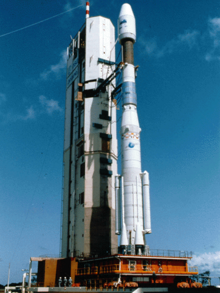TOPEX / Poseidon
| Topex / Poseidon | |
|---|---|

|
|
| Type: | Earth observation satellite |
| Country: |
|
| Operator: |
|
| COSPAR-ID : | 1992-052A |
| Mission dates | |
| Dimensions: | 2400 kg |
| Begin: | August 10, 1992, 23:08 UTC |
| Starting place: | CSG , ELA-2 |
| Launcher: | Ariane 4 2P V52 |
| Status: | out of service since January 2006 |
| Orbit data | |
| Rotation time : | 112.4 min |
| Orbit inclination : | 66 ° |
| Apogee height : | 1344 km |
| Perigee height : | 1331 km |
Topex / Poseidon was an earth observation satellite that NASA (USA) and CNES (France) jointly developed to measure changes in sea level levels and ocean currents . It was the first research satellite that could record the wave heights on the ocean using two specially developed radar sensors.
It was launched on August 10, 1992 with an Ariane 4 2P from Kourou . In January 2006 it was taken out of service after more than 13 years after the last gyroscope failed. A period of 3 to 5 years was planned. The direct Topex / Poseidon successor missions are the Jason-1, 2, and 3 Earth observation satellites . The data collected by Topex / Poseidon and its follow-up missions have shown a rise in sea level of 7 cm in 25 years.
platform
- The Fairchild Multi-Mission Spacecraft (MMS) was selected as the satellite platform for missions . This platform provided the:
- Command and data processing systems, including the main computer
- Altitude and attitude control systems to control the satellite
- Power supply systems with a nominal output of 2,100 watts, including the 8.7 × 3.3 meter solar panels and three batteries
- Telecommunications system that operated at a data transfer rate of 512 kilobytes per second
Observation instruments
TOPEX / Poseidon had five scientific instruments on board, two of which were experimental.
- Dual-Frequency TOPEX Radar Altimeter (ALT) was the main measuring instrument on board the satellite for measuring the sea surface using radar waves. It worked simultaneously in two frequency ranges of 13.6 GHz and 5.30 GHz to avoid measurement errors.
- TOPEX Microwave Radiometer (TMR) was a measuring instrument that was primarily used to measure the water vapor concentration in the atmosphere. It worked in three frequency ranges 18.7; 23.8 and 34 GHz
- Single-Frequency Poseidon Altimeter (SSALT) was an experimental radar sensor that operated in the Ku-band at 13.6 GHz.
- Doppler Orbitography and Radiopositioning Integrated by Satellite (DORIS)
- Global Positioning System Demonstration Receiver (GPSDR) experimental GPS receiver for determining the satellite position in earth orbit
Missionary tasks
- Determination of sea levels with an accuracy of better than 5 cm
- Observation of ocean currents
- Observational data to predict El Niño and La Niña
- Joint earth observation tasks with the successor satellite Jason-1 , which was launched in 2001
See also
Web links
- Homepage (English)
- Instruments (English)
- Press release on the mission end of January 2006 (English)
Individual evidence
- ↑ Orbit data at the beginning of the mission to Topex / Poseidon in the Encyclopedia Astronautica , accessed on June 11, 2012 (English).
- ↑ 25 Years of Global Sea Level Data, and Counting NASA website (English)
- ↑ a b c d Topex / Poseidon in the NSSDCA Master Catalog (English)
- ↑ Mission to Planet Earth, TOPEX / Poseidon NASA, Jet Propulsion Laboratory Pasadena (PDF file) (English)
- ↑ Topex Microwave Radiometer (English)
